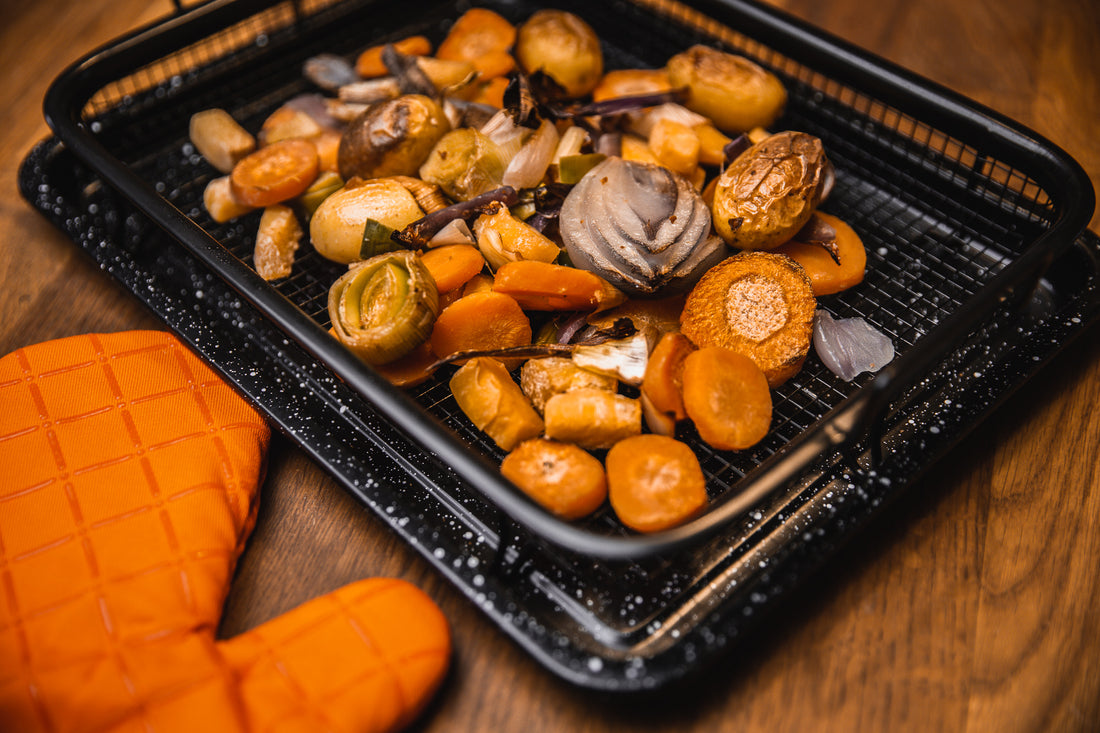Oven Roasted Root Vegetables
Root vegetables have long been a staple in the diets of various cultures around the world. These hardy, nutrient-dense vegetables are not only versatile but also bursting with flavour. One of the best ways to prepare root vegetables is by roasting them in the oven. This method enhances their natural sweetness, creates a delightful texture, and brings out a depth of flavour that is hard to match. In this article, we will delve into the world of oven roasted root vegetables, exploring their history, nutritional benefits, and providing a comprehensive guide to creating the perfect roast.
The History of Root Vegetables
Root vegetables have been cultivated and consumed by humans for thousands of years. They have been a crucial part of the diet in many cultures due to their ability to store well and provide essential nutrients during the winter months. Archaeological evidence suggests that ancient civilisations, such as the Egyptians, Greeks, and Romans, valued root vegetables for their sustenance and medicinal properties.
In Europe, root vegetables became particularly important during the Middle Ages. They were easy to grow in the harsh climates and provided a reliable food source during times of scarcity. Over the centuries, various types of root vegetables, including carrots, parsnips, potatoes, and beetroots, have been selectively bred and improved to increase their yield, flavour, and nutritional content.
Nutritional Benefits of Root Vegetables
Root vegetables are a powerhouse of nutrition. They are rich in vitamins, minerals, and dietary fibre, making them an excellent choice for a healthy diet. Here are some of the key nutritional benefits of common root vegetables:
- Carrots: Carrots are high in beta-carotene, which the body converts into vitamin A. This vitamin is essential for good vision, immune function, and skin health. Carrots also provide fibre, vitamin K1, and potassium.
- Parsnips: Parsnips are a good source of vitamin C, vitamin K, and folate. They also contain antioxidants and are rich in fibre, which aids digestion and promotes a healthy gut.
- Potatoes: Potatoes are an excellent source of vitamin C, potassium, and vitamin B6. They also provide carbohydrates, which are a primary energy source for the body. Additionally, potatoes contain resistant starch, which acts as a prebiotic and supports gut health.
- Beetroots: Beetroots are packed with vitamins and minerals, including folate, manganese, and potassium. They also contain nitrates, which have been shown to improve blood flow and lower blood pressure. The betalains in beetroots have anti-inflammatory properties.
- Sweet Potatoes: Sweet potatoes are rich in beta-carotene, vitamin C, and potassium. They also provide fibre and antioxidants, which can help protect against chronic diseases.
The Art of Roasting Root Vegetables
Roasting root vegetables is a simple yet effective way to bring out their natural flavours. The dry heat of the oven caramelises the sugars in the vegetables, creating a sweet, rich, and slightly crispy exterior while keeping the inside tender and moist. Here is a step-by-step guide to achieving perfectly roasted root vegetables.
Step 1: Choosing Your Vegetables
When selecting root vegetables for roasting, choose a variety of types and colours to create a visually appealing and flavourful dish. Some popular options include:
- Carrots
- Parsnips
- Potatoes (both regular and sweet potatoes)
- Beetroots
- Turnips
- Radishes
- Rutabagas
Step 2: Preparing the Vegetables
- Washing and Peeling: Thoroughly wash the vegetables to remove any dirt. Peeling is optional and depends on personal preference and the type of vegetable. For instance, young carrots and potatoes can be roasted with their skins on, while older, thicker-skinned vegetables may benefit from peeling.
- Cutting: Cut the vegetables into uniform pieces to ensure even cooking. Aim for bite-sized chunks, roughly 1-2 inches in size. Smaller pieces will cook faster and become crispier, while larger pieces will be softer and more tender inside.
Step 3: Seasoning
- Oil: Toss the vegetables in a generous amount of oil to ensure they roast evenly and develop a crispy exterior. Olive oil is a popular choice due to its flavour and health benefits, but other oils, such as avocado oil or coconut oil, can also be used.
- Herbs and Spices: Season the vegetables with a blend of herbs and spices to enhance their flavour. Some classic combinations include:
- Rosemary, thyme, and garlic
- Paprika, cumin, and coriander
- Sage, oregano, and marjoram
- Salt and Pepper: Don’t forget to add salt and pepper to taste. Salt helps to draw out moisture and concentrate the flavours, while pepper adds a subtle heat.
Step 4: Roasting
- Preheat the Oven: Preheat your oven to 200°C (400°F). A hot oven is crucial for achieving that perfect balance of crispy exterior and tender interior.
- Arranging the Vegetables: Spread the seasoned vegetables in a single layer on a crisper tray (Pep Crisper Tray is available HERE). Ensure they are not overcrowded, as this can lead to steaming rather than roasting.
- Roasting Time: Roast the vegetables in the preheated oven for 25-35 minutes, or until they are golden brown and tender. Halfway through the cooking time, stir the vegetables or shake the baking sheet to promote even cooking.
- Checking for Doneness: Use a fork or skewer to test the vegetables for doneness. They should be easily pierced and have a caramelised exterior.
Step 5: Serving
Serve the roasted root vegetables hot from the oven as a side dish or incorporate them into other recipes. They pair beautifully with roasted meats, grilled fish, or can be added to salads, grain bowls, and soups for added flavour and nutrition.
Variations and Recipes
While the basic method of roasting root vegetables is straightforward, there are numerous ways to customise the dish to suit your taste preferences and dietary needs. Here are some variations and recipes to inspire your culinary creativity:
- Honey Glazed Roasted Root Vegetables: Toss the vegetables in a mixture of olive oil, honey, and a splash of balsamic vinegar before roasting. The honey adds a delightful sweetness and the vinegar provides a tangy contrast.
- Spicy Roasted Root Vegetables: Add a pinch of chilli flakes or a drizzle of sriracha to the seasoning mix for a spicy kick. This variation pairs well with cooling yoghurt or creamy dips.
- Mediterranean Roasted Root Vegetables: Season the vegetables with olive oil, lemon juice, oregano, and feta cheese. Add olives and sun-dried tomatoes for an extra burst of Mediterranean flavour.
- Maple Roasted Root Vegetables: Substitute the honey with maple syrup for a different sweet note. This version is particularly delicious with sweet potatoes and carrots.
- Herb-Roasted Root Vegetables: Experiment with different herb combinations such as dill, tarragon, and chives. Fresh herbs can be added towards the end of roasting or sprinkled on top just before serving.
- Roasted Root Vegetable Salad: Once roasted, toss the vegetables with mixed greens, nuts, and a light vinaigrette for a warm salad. Add grains like quinoa or farro for a more substantial meal.
Troubleshooting Tips
While roasting root vegetables is generally straightforward, a few common issues can arise. Here are some troubleshooting tips to ensure your dish turns out perfectly every time:
- Soggy Vegetables: If your vegetables are turning out soggy instead of crispy, ensure they are spread out in a single layer on the tray. Overcrowding can cause them to steam rather than roast. Additionally, using enough oil and roasting at a high temperature can help achieve a crispy texture.
- Uneven Cooking: To prevent some pieces from being overcooked while others are undercooked, cut the vegetables into uniform sizes. Stirring or shaking the pan halfway through the cooking time also promotes even roasting.
- Burnt Edges: If the edges of your vegetables are burning before the centres are cooked through, try reducing the oven temperature slightly or covering the vegetables loosely with aluminium foil for part of the cooking time.
- Lack of Flavour: Don’t be shy with the seasoning. Ensure the vegetables are well-coated with oil, herbs, and spices before roasting. Taste and adjust the seasoning as needed before serving.
Oven roasted root vegetables are a delightful addition to any meal. Their rich flavours, appealing textures, and nutritional benefits make them a versatile and valuable component of a healthy diet. By following the steps and tips outlined in this article, you can master the art of roasting root vegetables and explore a world of culinary possibilities. Whether served as a simple side dish or incorporated into more complex recipes, oven roasted root vegetables are sure to become a favourite in your culinary repertoire.

